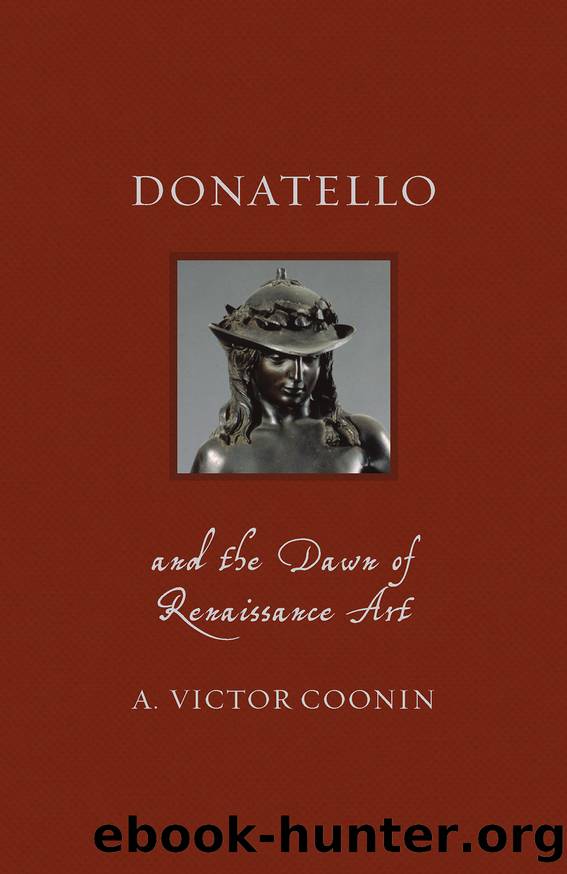Donatello and the Dawn of Renaissance Art by A. Victor Coonin

Author:A. Victor Coonin
Language: eng
Format: epub
Publisher: Reaktion Books
54 Donatello, decorations in the Old Sacristy of San Lorenzo, Florence, c. 1439–43.
Early commentators pulled no punches. Antonio Manetti, in his biography of Brunelleschi (c. 1475), accuses Donatello of working ‘with such pride and arrogance that he installed [doorway decorations] without ever consulting Brunelleschi’. Manetti, a staunch Brunelleschi partisan, added, ‘What he did in the sacristy, individually and collectively, utterly lacked the grace of Brunelleschi’s forms.’ Manetti claims that Brunelleschi even composed sonnets to exonerate himself from any blame having to do with Donatello’s interventions. In his book on architecture, written between 1461 and 1464, Filarete, who praised Donatello’s St George as ‘perfect’, criticized Donatello’s figures on the bronze doors on either side of the altar space by stating, ‘If you have to do apostles, do not make them look like fencers, as Donatello did in the two bronze doors in the sacristy of S. Lorenzo in Florence.’66 Antonio Billi, a sixteenth-century biographer of artists, mentions the Old Sacristy doors around 1530, ‘even though they are not very graceful’. The Florentine artist Baccio Bandinelli wrote to Duke Cosimo Ii de’ Medici in 1547 criticizing the Old Sacristy doors and bronze pulpits as coarse. Other artists and commentators also praised Donatello’s work in the Old Sacristy. Vasari, in particular, had no reservations about its beauty, and Francesco Bocchi, in his guidebook of 1591, describes individual works as well as the whole and concludes that, ‘artists visiting this place enjoy the sweetest delight imaginable’.
Creatively, Donatello tried some daring and original techniques for the time, and it is easy to lose sight of that fact. The upper stucco work is the most innovative. With the stucco, Donatello explored the possibilities of adding a varied palette of colour to the three-dimensionality of relief sculpture. It was not new to paint stucco or even terracotta, but to do so with narrative scenes using the progressive new techniques of mathematical perspective was unprecedented. In effect, Donatello sought a logical next step forward from rilievo schiacciato by adding colour to relief sculpture. In hindsight, it is easy to see glazed terracotta, as developed by Luca della Robbia, as the more elegant and beautiful development in this type of sculptural appendage, but mastery of the technique was still almost a decade away and its success was far from evident at the time of the Old Sacristy decoration.67 Still, Donatello never again went back to painted stucco on this scale.
For practical reasons, interior decoration was traditionally installed from the top of the interior downwards, and that is a logical way to assess the Old Sacristy decorations because, except for modelling the wax forms from which the bronze doors were cast, Donatello worked in situ. The narrative roundels in the pendentives comprise the most daring parts of the overall decoration and presented difficult challenges because their surfaces are concave as they follow the curvature of the pendentives. They also betray extreme experimentation undertaken in a context where speed was of the essence. Conservation work has shown in detail how Donatello used nails to support the damp stucco, which he worked by hand, leaving fingerprints in the process.
Download
This site does not store any files on its server. We only index and link to content provided by other sites. Please contact the content providers to delete copyright contents if any and email us, we'll remove relevant links or contents immediately.
The Japanese by Christopher Harding(1086)
Watercolor With Me in the Forest by Dana Fox(753)
A Theory of Narrative Drawing by Simon Grennan(742)
The Story of the Scrolls by The Story of the Scrolls; the M(725)
Glittering Images: A Journey Through Art From Egypt to Star Wars by Camille Paglia(717)
Boris Johnson by Tom Bower(620)
This Is Modern Art by Kevin Coval(599)
The Art and Science of Drawing by Brent Eviston(591)
Frida Kahlo by Frida Kahlo & Hayden Herrera(586)
AP Art History by John B. Nici(575)
Banksy by Will Ellsworth-Jones(569)
War Paint by Woodhead Lindy(551)
Van Gogh by Gregory White Smith(547)
Scenes From a Revolution by Mark Harris(544)
Draw More Furries by Jared Hodges(544)
About Looking by John Berger(543)
Ecstasy by Eisner.;(535)
100 Greatest Country Artists by Hal Leonard Corp(523)
Young Rembrandt: A Biography by Onno Blom(514)
